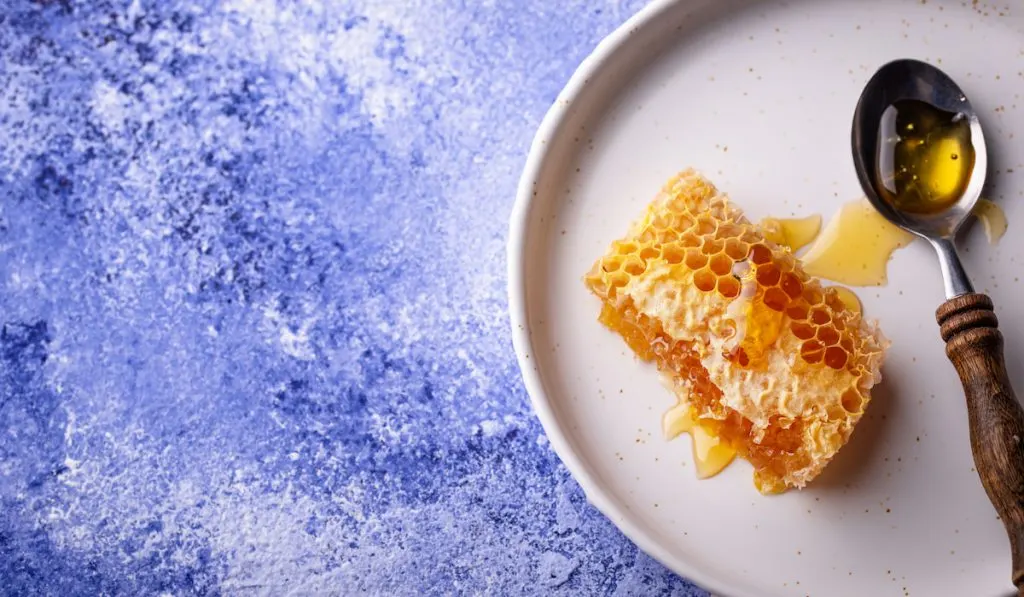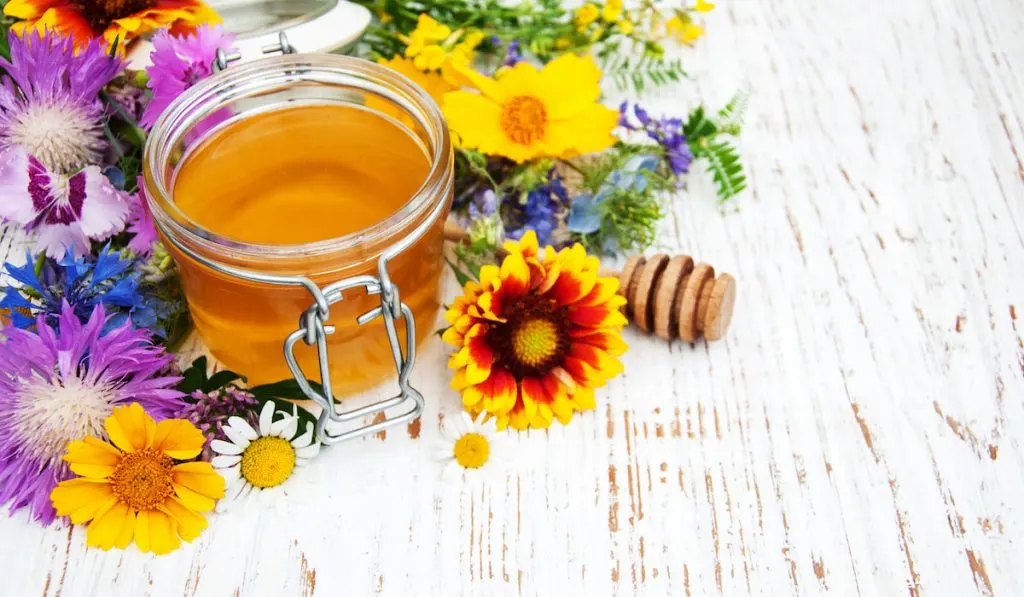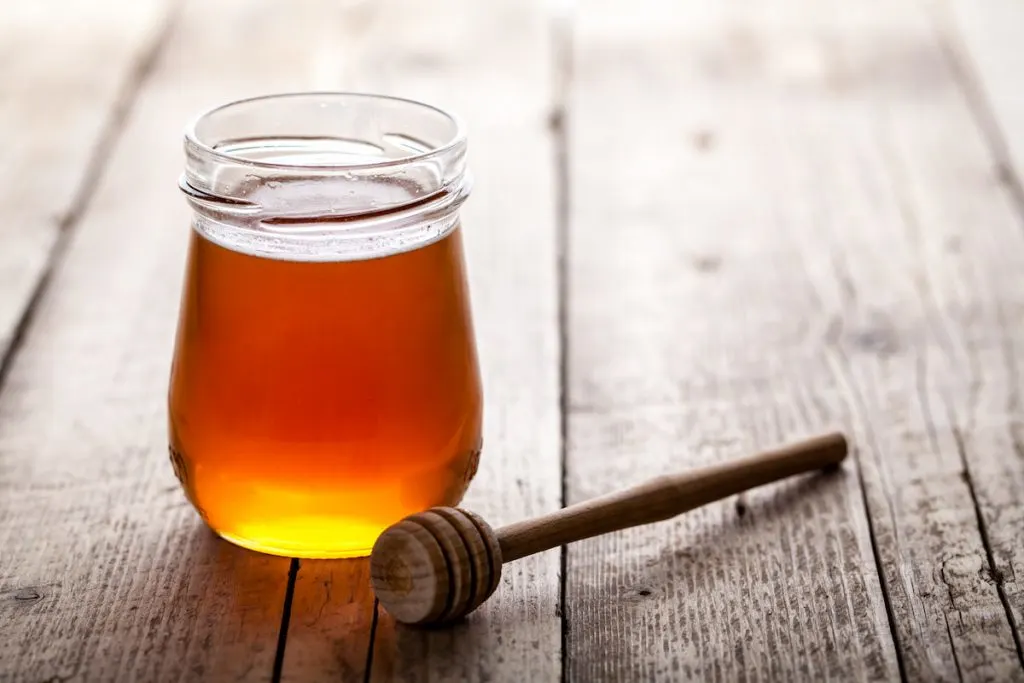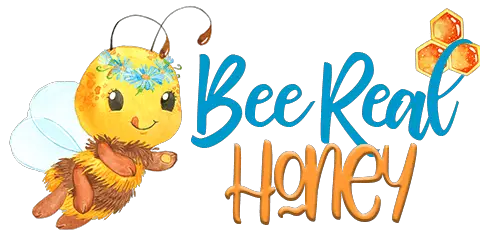*This post may have affiliate links, which means I may receive commissions if you choose to purchase through links I provide (at no extra cost to you). As an Amazon Associate I earn from qualifying purchases. Please read my disclaimer for additional details..
Honey is a favorite sweet snack and condiment for many of us and has been enjoyed for thousands of years.
This natural treat comes in a number of varieties, and it can become a little confusing to understand the differences between each type.
Wildflower honey is special because it typically goes through less processing in production and offers unique flavors depending on the plants that the nectar is collected from.
This honey typically has no artificial flavoring and coloring, giving it a raw taste, and is often available in organic varieties.
Table of Contents
What is Honey?
Honey is made from the nectar that bees collect from flowers.
Nectar is a sweet, sticky substance found deep in flower blossoms that attracts bees to plants to encourage pollination.

As the bees move from blossom to blossom, they use their tongues to collect and drink nectar.
They store it in a special stomach separate from the stomach they use for digesting their own food.
When they are full with nectar, the bees fly back to the hive.
There, they deposit the collected nectar for other bees to help break down and store in the honeycomb. This way, the bees have a backup food source for colder months or when it is harder for them to find an energy source.
What Makes Wildflower Honey Special?
Wildflower honey is a byproduct of the pollination process carried out naturally by bees.
Since bees move from flower to flower, they will mix the plants that they collect nectar from in a given outing. Because of this, wildflower honey is also known as polyfloral honey (coming from multiple flowers).
Wildflower honey is unique since it can have a different flavor or coloring depending on the predominant flower that the nectar is collected from.
Types of Wildflower Honey
Wildflower honey is mainly classified by the dominant flavor produced from the plant(s) it is collected from.
Consistency across batches and brands can vary since wildflower honey is naturally derived based on when and where the bees collect it.

Wildflower honey can vary when collected in the same region as the seasons change.
For example, honey collected from the same hives during the winter may taste different than in the summer since there are different plants and nectars available based on the season.
When choosing a type of wildflower honey to purchase, you will have an amazing variety of scents, taste, and color to pick from.
1. Apple Blossom Honey

Apple blossom honey originates from apple blossoms and is a rare kind found mainly in summer in Southern Ontario apple orchards. However, you may be able to find it at local grocery stores or online.
Apple blossom honey is a light golden brown color with the sweet and fresh aroma of apple.
It produces an aftertaste of subtle fruit tones but is not overly sweet, which reflects the nectar used to collect and produce it.
In fact, since apple blossom nectar itself is not very sweet, bees are less frequently attracted to it. This contributes to the scarcity of the honey.
Apple blossom honey may be used in tea, on toast, or even as drizzle on your favorite dessert. Because this is a rare variety, the cost may be a bit higher than what you would expect, ranging from around 20-45 dollars.
2. Clover Honey

Clover honey is one of the most popular types of honey used most commonly for teas, baking, and general cooking.
It is mild in taste with a light amber color but has a more complex taste than over the counter sugar, making it popular with honey enthusiasts and bakers.
Clover honey may vary in color depending on the season. It tends to be thick in texture and sweet.
When you purchase raw clover honey, there should be no added flavors or preservatives.
Clover honey is among the most popular varieties and is more reasonably priced. You can find it in most grocery stores for 10-20 dollars depending on the amount.
3. Gallberry Honey
- Bold, Distinctive Flavor Profile: Real gallberry blossom honey with a strong and sweet aromatic flavor. Great for connoisseurs of bold honey flavors with unmatched richness & aroma. Ideal for baking, roasting, gourmet recipes, sweetening teas & more.
- Authentic Amish Extremely Raw Honey: 100% natural raw honey, sourced from small-batch Amish beekeepers for a selection of mild, bold, tangy, rich & sweet flavors. Unblended and pure to preserve purity, texture, and exceptional natural taste.
Gallberry honey is sourced from a small evergreen holly bush, also known as an inkberry.
Native to the lowlands of Southern Georgia and Northern Florida, this plant is very rare to find elsewhere, as it thrives in the warm and humid climate.
Gallberry honey is a rich honey with medium flavor that is good daily use as well as special occasions. The color varies from light to medium amber color.
This wildflower honey can be found in many grocery stores and online. The average price for a 12-ounce jar of Gallberry honey ranges from 12-20 dollars depending on the seller, location, and season, all of which can impact availability and demand.
4. Lavender Honey
- Estimated Product Size: 1 jar – 8.8 oz
- Country of Origin: France
Lavender honey features a medium amber-colored syrup and a delicate, flowery scent reflecting the lavender blossoms that produce it. It has a medium sweet taste that can grow even sweeter with time.
Originating in France, Italy, and Spain, lavender plants are popular globally and can be found in small gardens as well as forest landscapes.
These plants bloom from mid-spring through late summer.
Bees are attracted to lavender blossoms with the combination of strong scent and vibrant color.
This prompts them to frequent these plants and creating an abundance of lavender honey, mainly in the spring and summer seasons.
Lavender honey is commonly found in grocery stores and online and is perfect for pairing with cheeses and crackers. Prices typically range from 15-26 dollars.
5. Orange Blossom Honey
- Invite the fragrance of a blossoming orange grove to your table.
- HoneyTree’s Orange Blossom honey has a sweet delicate flavor and a bountiful floral aroma.
Orange blossom honey is produced from the nectar of orange trees growing in parts of Texas, Florida, and Southern California.
Mainly coming from blossoms, it can also be created from a combination of other citrus sources.
Orange blossom honey is commonly a light brown color tinged with orange. It has a mildly sweet flavor with clear citrus notes.
This honey is great for use in tea or pairing with bread and cheese
You can find this honey in grocery stores as well as online. Its price ranges from 12-30 dollars depending on the amount needed.
Wildflower Honey Benefits
Wildflower honey has many natural benefits which will differ depending on the variety and flower.
These outcomes vary from person to person but may be worth trying depending on your health and beauty needs.

Some common health benefits when eating or cooking with wildflower honey include:
- Great source of antioxidants
- Natural way to boost the immune system
- Fights infections and colds
- Soothes sore throats
- Contains many vitamins and minerals
- Aids digestion
You can also benefit from wildflower honey when used physically on the body:
- Keeps skin young tight and healthy when frequently applied to the skin
- Used to treat burns and reduce inflammation
- Acts as a moisturizer for hair to keep it bright and soft
- Moisturizes skin
Wildflower Honey Prices
The cost of wildflower honey will vary based on a number of factors including scarcity, container size, region, and demand.
We’ve summarized the average costs in the table below based on an 8 ounce container.
| Type | Usage | Price per 8oz |
| Blackberry Honey | BBQ sauce and tea | $7.50-12.00 |
| Buckwheat Honey | Supports immune health, soothes coughs, can be used for a skincare regimen. | $5.00-12.00 |
| Chestnut Honey | Provides Vitamins B and C. Strengthens muscle and bone health. | $9.50-20.00 |
| Cotton Honey | Excellent as table honey and pairs well with cheese. | $6.30-12.50 |
| Eucalyptus Honey | Relieves respiratory troubles and aids in coughing and sore throats. | $11.00-20.00 |
| Key Lime Honey | Adds sweetness to teas pairs well with breads. | $12.95-25.95 |
| Manuka Honey | Provides antioxidants | $21.00-30.50 |
| Pumpkin Honey | Rich in antioxidants and works as an anti-inflammatory. | $14.00-20.50 |
Resources
- https://diethive.com/wildflower-honey/
- http://localhoneyfinder.org/TypesAndFlavorsOfHoney.php
- https://www.24mantra.com/blogs/organic-food/6-reasons-why-organic-wildflower-honey-is-good-for-your-health/
- https://glorybee.com/honey
- https://www.heritagebees.com/LocalWilflowerHoney
- https://www.beesponsible.com/
